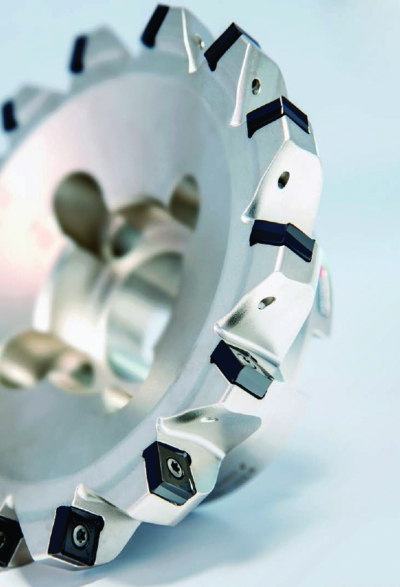
Cutting Solutions by CERATIZIT has introduced the MaxiMill 491 milling system, engineered for easier use, more parts per shift, faster changeovers and profiles of exactly 90°. The MaxiMill 491 system offers eight smooth-cutting edges per insert to provide significant increases in production and savings, the company said.
“Precision and productivity are always make-or-break issues in machining,” said Robert Bokram, product manager for end user cutting tools at CERATIZIT USA. “Testing shows the new MaxiMill 491 system not only maintains 90° accuracy, it also boosts production in a wide range of materials.”
The system features a new portfolio of carbide grades, BLACKSTAR and SILVERSTAR, and is a major reason why the MaxiMill 491 shoulder milling system is economical. With MaxiMill 491, Cutting Solutions by CERATIZIT is technologically exploring new design features. "Many shoulder milling systems in the market feature an extremely complex design,” Bokram said. “We rethought the milling process and simplified the approach."
The MaxiMill 491 system has an attractive price per cutting edge, Bokram said. The inserts are produced to tolerance H and guarantee outstanding axial and radial runout, long tool life and high-quality surfaces. Irregular pitch and perfectly adapted approach angles reportedly ensure reduced vibration, smooth cutting and low power consumption.
The system also roughs and finishes, resulting in fewer changeovers and more parts per shift. The MaxiMill 491 system is suitable for universal application, including facemilling, shoulder milling, peripheral milling, slotting and trochoidal slotting.
The MaxiMill 491 system comes in sizes from 1.50” to 6.00” in diameter and SNHU precision inserts with a corner radius of 0.031”. Shell milling cutters are available with a wide or narrow pitch. Shank style tools are available in 1.25” in diameter. The standard -F, -M, -R chip grooves combined with the latest grade technologies are used in steel, cast iron, stainless steel and aluminium in ISO ranges P-K-M-N.
Contact Details
Related Glossary Terms
- facemilling
facemilling
Form of milling that produces a flat surface generally at right angles to the rotating axis of a cutter having teeth or inserts both on its periphery and on its end face.
- gang cutting ( milling)
gang cutting ( milling)
Machining with several cutters mounted on a single arbor, generally for simultaneous cutting.
- milling
milling
Machining operation in which metal or other material is removed by applying power to a rotating cutter. In vertical milling, the cutting tool is mounted vertically on the spindle. In horizontal milling, the cutting tool is mounted horizontally, either directly on the spindle or on an arbor. Horizontal milling is further broken down into conventional milling, where the cutter rotates opposite the direction of feed, or “up” into the workpiece; and climb milling, where the cutter rotates in the direction of feed, or “down” into the workpiece. Milling operations include plane or surface milling, endmilling, facemilling, angle milling, form milling and profiling.
- peripheral milling
peripheral milling
Form of milling that produces a finished surface generally in a plane parallel to the rotating axis of a cutter having teeth or inserts on the periphery of the cutter body. See milling.
- pitch
pitch
1. On a saw blade, the number of teeth per inch. 2. In threading, the number of threads per inch.
- shank
shank
Main body of a tool; the portion of a drill or similar end-held tool that fits into a collet, chuck or similar mounting device.
- slotting
slotting
Machining, normally milling, that creates slots, grooves and similar recesses in workpieces, including T-slots and dovetails.
- tolerance
tolerance
Minimum and maximum amount a workpiece dimension is allowed to vary from a set standard and still be acceptable.








